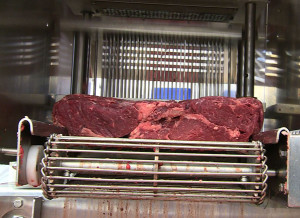In a move to cut risk from foodborne E. coli, all mechanically tenderized beef (MTB) sold in Canada from today on must be labelled as such and list instructions on safe cooking.
 Health Minister Rona Ambrose on Thursday announced the new labelling requirements for all uncooked MTB — expanding a rule that’s been in place since July last year for federally licensed beef plants producing steaks and roasts.
Health Minister Rona Ambrose on Thursday announced the new labelling requirements for all uncooked MTB — expanding a rule that’s been in place since July last year for federally licensed beef plants producing steaks and roasts.
The new label must clearly state the beef being sold is “mechanically tenderized,” and must include instructions for safe cooking, stressing the importance of cooking MTB to a minimum internal temperature of 145 F (63 C) and turning over steaks at least twice during cooking.
The Canadian Food Inspection Agency (CFIA) is tasked with verifying retailers’ and packers’ labels meet the new requirements, Health Canada said.
Mechanical tenderization is a common practice for improving beef tenderness and flavour, using needles or blades to break down, penetrate or pierce the meat’s surface and disrupt the muscle fibers, or to inject the meat with a marinade or tenderizer.
 Normally, the risk of E. coli contamination from a rare or undercooked steak, roast or other solid cut of beef is “not a significant concern” since such bacteria would normally be on the surface of the meat and “inactivated” during cooking.
Normally, the risk of E. coli contamination from a rare or undercooked steak, roast or other solid cut of beef is “not a significant concern” since such bacteria would normally be on the surface of the meat and “inactivated” during cooking.
Much like grinding beef, mechanical tenderization can increase the potential for bacteria to transfer from the surface to the centre of the meat.
Unlike ground beef, however, as a Health Canada health risk assessment pointed out last year, it’s “not necessarily apparent by just looking at a mechanically tenderized meat product that it has undergone this process.”
The May 2013 assessment showed “a five-fold increase in risk from MTB products when compared to intact cuts of beef.”
Health Canada noted that in 2012, out of 18 cases of foodborne E. coli O157-related illness from a Canadian outbreak linked to contaminated beef, five cases were considered to be “likely associated with the consumption of beef that had been mechanically tenderized at the retail level.”
The rule covers all solid cuts of MTB, regardless of thickness, which means it will also apply to cubed steaks, “fast fry” or “minute” steaks. It will apply to both pre-packaged and non-pre-packaged products.
MTB that’s packaged on the premises at selection or purchase — such as in a butcher shop or at a clerk-served meat counter — will need to be identified as such before the customer selects a desired cut of beef. An in-store sign would identify a product in a display case as “mechanically tenderized,” for example.
In those cases, once meat has been packaged to give to the customer, the product must carry both the mandatory “mechanically tenderized” label and safe cooking instructions on the “principal display panel.”
